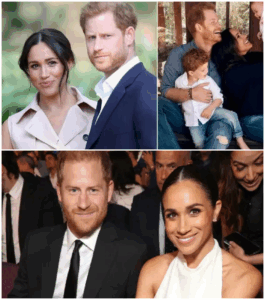A Royal Shift: Archie and Lilibet Now Formally Titled Prince and Princess
Montecito, California – Since stepping back from senior royal duties in 2020, Prince Harry and Meghan Markle, the Duke and Duchess of Sussex, have actively shaped a distinct family identity. A significant part of this evolution is the formal use of “Prince” and “Princess” titles for their children, Archie and Lilibet, a change that came into effect following the accession of King Charles III.
Stepping Back and Shaping a New Path
In early 2020, Prince Harry and Meghan made headlines with their decision to step back from official royal duties. Following discussions with Queen Elizabeth II, it was agreed they would no longer use the “Sussex Royal” brand. They pivoted their online presence and efforts to the Archewell Foundation, a charitable organization named after their first child, Archie Harrison Mountbatten-Windsor.
Since their move to California, the Duke and Duchess have focused on a range of philanthropic initiatives, media production, and advocacy work through Archewell, carving out a new purpose-driven life.
.
.
.

Archie and Lilibet: New Titles After Royal Accession
When Archie was born in 2019, he did not automatically receive a royal title due to a 1917 Letters Patent issued by King George V. However, the royal landscape shifted significantly after Queen Elizabeth II’s passing and King Charles III’s accession in 2022. This change made both Archie and his younger sister, Lilibet, eligible for royal titles as grandchildren of the reigning monarch through the male line.
In March 2023, a spokesperson for the Duke and Duchess of Sussex officially confirmed that their children would indeed be referred to as Prince Archie of Sussex and Princess Lilibet of Sussex.
Surnames and Royal Naming Conventions
Traditionally, descendants of Queen Elizabeth II and Prince Philip who do not hold royal titles have used the surname Mountbatten-Windsor. While Archie and Lilibet now use their Prince and Princess titles, there has been no official announcement confirming any legal change to their surname from Mountbatten-Windsor to Sussex.
It’s a common royal convention for titled family members to be primarily referred to by their titles in official and public contexts, which is how Prince Archie and Princess Lilibet are now formally identified.
Meghan Markle’s Reflections on Family Identity
In a conversation with actress Mindy Kaling, Meghan Markle reflected on the deep personal meaning of sharing a unified family identity and name with her children. However, her remarks were understood to express emotional unity rather than an official statement about a legal surname alteration.
The couple has also updated their public-facing website to Sussex.com, further reflecting their emphasis on the Sussex title in their communications and public branding. Their Archewell Foundation continues its vital work in charitable initiatives and advocacy.
Public Reactions and Forward Focus
Public reactions to the use of Archie and Lilibet’s royal titles have been varied. Some observers support the couple maintaining a connection to their royal heritage, while others have debated the balance between privacy and public visibility. Despite differing opinions, Prince Harry and Meghan have consistently maintained their focus on their personal and charitable endeavors.
Conclusion: A Family Forging Its Own Path
Prince Harry and Meghan Markle continue to build a life centered on philanthropy, media work, and advocacy, while respectfully acknowledging their family’s royal heritage. Their children, Archie and Lilibet, are now officially recognized as Prince and Princess of Sussex, reflecting their established place within the royal family structure.
With no official confirmation of a legal surname change, the Duke and Duchess of Sussex remain committed to shaping a future for their family in California, guided by their values and vision.
News
Drew Sets His Sights on Trina—Shattering Curtis and Portia’s World on General Hospital
Drew Sets His Sights on Trina—Shattering Curtis and Portia’s World on General Hospital Last week on General Hospital, viewers watched…
Jason Finally Finds Britt—But Her Heartbreaking Confession Leaves Him in Tears on ABC’s General Hospital
Jason Finally Finds Britt—But Her Heartbreaking Confession Leaves Him in Tears on ABC’s General Hospital The picturesque Croatian city of…
Explosive Twists Ahead on General Hospital: Ava Betrays Rick, Jason Hunts for Britt, and Joss Embarks on a Secret Spy Mission—Plus, Cast Romance Rumors Ignite Social Media!
Explosive Twists Ahead on General Hospital: Ava Betrays Rick, Jason Hunts for Britt, and Joss Embarks on a Secret Spy…
Shocking Revelation Rocks Port Charles: Trina Stunned to Learn Kai Is Drew’s Long-Lost Son — Explosive General Hospital Spoilers!
Shocking Revelation Rocks Port Charles: Trina Stunned to Learn Kai Is Drew’s Long-Lost Son — Explosive General Hospital Spoilers! Welcome…
Explosive ABC General Hospital Spoilers: Full Recap & Shocking Twists for Wednesday, August 6, 2025
Explosive ABC General Hospital Spoilers: Full Recap & Shocking Twists for Wednesday, August 6, 2025 Welcome back to Port Charles,…
Tristan Rogers Delivers Heartbreaking News That Leaves General Hospital Fans in Tears | ABC GH Updates
Tristan Rogers Delivers Heartbreaking News That Leaves General Hospital Fans in Tears | ABC GH Updates In the dazzling world…
End of content
No more pages to load








